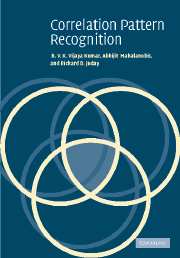Book contents
1 - Introduction
Published online by Cambridge University Press: 06 August 2009
Summary
There are many daily pattern recognition tasks that humans routinely carry out without thinking twice. For example, we can recognize those that we know by looking at their face or hearing their voice. You can recognize the letters and words you are reading now because you have trained yourself to recognize English letters and words. We can understand what someone is saying even if it is slightly distorted (e.g., spoken too fast). However, human pattern recognition suffers from three main drawbacks: poor speed, difficulty in scaling, and inability to handle some recognition tasks. Not surprisingly, humans can't match machine speeds on pattern recognition tasks where good pattern recognition algorithms exist. Also, human pattern recognition ability gets overwhelmed if the number of classes to recognize becomes very large. Although humans have evolved to perform well on some recognition tasks such as face or voice recognition, except for a few trained experts, most humans cannot tell whose fingerprint they are looking at. Thus, there are many interesting pattern recognition tasks for which we need machines.
The field of machine learning or pattern recognition is rich with many elegant concepts and results. One set of pattern recognition methods that we feel has not been explained in sufficient detail is that of correlation filters. One reason why correlation filters have not been employed more for pattern recognition applications is that their use requires background in and familiarity with different disciplines such as linear systems, random processes, matrix/vector methods, statistical decision theory, pattern recognition, optical processing, and digital signal processing.
- Type
- Chapter
- Information
- Correlation Pattern Recognition , pp. 1 - 12Publisher: Cambridge University PressPrint publication year: 2005



